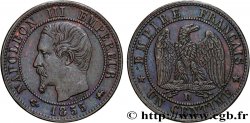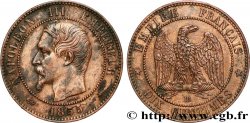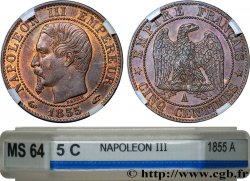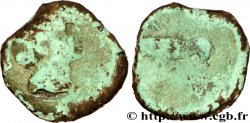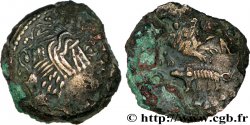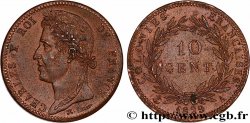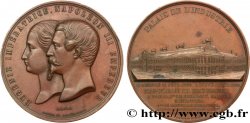fme_615503 - SECOND EMPIRE Médaille, Napoléon III et Eugénie, Palais de l’Industrie
140.00 €
Количество
Добавить в корзину

Тип Médaille, Napoléon III et Eugénie, Palais de l’Industrie
Дата: 1855
Монетный двор / Город: 75 - Paris
Металл: copper
Диаметр: 68 mm
Ориентация осей монеты: 12 h.
Гравер CAQUÉ Armand Auguste (1795-1881)
Вес: 167,7 g.
Век: Lisse + main CUIVRE
Пуансон: main indicatrice (1845-1860) et CUIVRE
Комментарии о состоянии
Patine marron avec des coups et rayures. Beaux reliefs malgré une légère usure sur certains reliefs
Ссылки в каталоге: :
Лицевая сторона
Аверс: легенда: EUGÈNIE IMPÉRATRICE. NAPOLÉON III EMPEREUR.
Аверс: описание: Bustes accolés d’Eugénie et Napoléon III; signé : CAQUE. F. / GRAVEUR DE S.M.L’EMPEREUR.
Обратная сторона
Реверс: легенда: PALAIS DE L’INDUSTRIE, (LÉGENDE SUPÉRIEURE); COMMENCE 10 FÉVR : 1853. ACHEVÉ AVRIL 1855. / NAPOLÉON III EMPEREUR / A. FOULD, CTE DE PERSIGNY, MAGNE / MINISTRES. / VTE DE ROUVILLE DIRECTEUR. / ARDOIN, RICARDO, BOUISSIN ADMIN / VIEL ARCHIT: BARRAULT ING / GERVAIS ET CNE EDIT., (EN 8 LIGNES À L’EXERGUE).
Реверс: Описание: Vue axonométrique sur le Palais de l’industrie.
Комментарий
L’exposition universelle fut décrétée pour le 15 mai 1855 pour témoigner au monde entier de la prospérité de la France, suite à l’exemple de l’Angleterre en 1851. Napoléon III inaugura cette première exposition universelle française en déclarant : “j’ouvre avec bonheur ce temple de la paix qui convie tous les peuples à la concorde”.
Le palais de l’industrie étonna par sa construction métallique et la hardiesse de la nef centrale haute de 35 mètres. Construit de 1853 à 1855, sur les plants de l’architecte Jean-Marie VIel (1797-1863), il forme un parallélogramme de fonte et de verre à deux étages, dont les façades principales ont 252 mètres de long, et les façades latérales 108 mètres. Il est composé d’un pavillon central et de pavillons d’angle. L’entrée principale se compose d’une immense arcade, flanquée de chaque côté de colonnes corinthiennes et surmontées d’une attique que décorent un bas-relief.
Le palais subsistera jusqu’en 1900 pour ensuite être démoli et remplacé par les Petit et Grand Palais actuels construits pour l’Exposition Universelle de Paris en 1900.
Source : Médailles de Napoléon III, Hess Divo.
Le palais de l’industrie étonna par sa construction métallique et la hardiesse de la nef centrale haute de 35 mètres. Construit de 1853 à 1855, sur les plants de l’architecte Jean-Marie VIel (1797-1863), il forme un parallélogramme de fonte et de verre à deux étages, dont les façades principales ont 252 mètres de long, et les façades latérales 108 mètres. Il est composé d’un pavillon central et de pavillons d’angle. L’entrée principale se compose d’une immense arcade, flanquée de chaque côté de colonnes corinthiennes et surmontées d’une attique que décorent un bas-relief.
Le palais subsistera jusqu’en 1900 pour ensuite être démoli et remplacé par les Petit et Grand Palais actuels construits pour l’Exposition Universelle de Paris en 1900.
Source : Médailles de Napoléon III, Hess Divo.








 Cообщить об ошибке
Cообщить об ошибке Распечатать страницу
Распечатать страницу Отправить мой выбор
Отправить мой выбор Задать вопрос
Задать вопрос Consign / sell
Consign / sell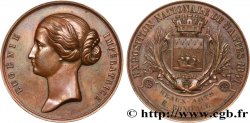
 Информация
Информация

